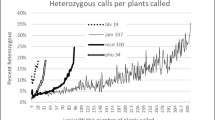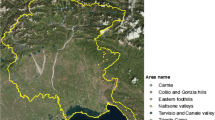Abstract
Polysomic inheritance frequently results in the simultaneous occurrence of several microsatellite DNA alleles on a single locus. The MAC-PR (microsatellite DNA allele counting—peak ratios) method was recently developed for the analysis of polyploid plants and makes use of the quantitative values for microsatellite allele peak areas. To date, this approach has only been used in plants with known genetic relationships. We report here the application of MAC-PR for the first time to random samples of unknown pedigrees. We analysed six microsatellite loci using a set of tetraploid ornamental rose (Rosa × hybrida L.) varieties. For each locus, all alleles were analysed in pairwise combinations in order to determine their copy number in the individual samples. This was accomplished by calculating the ratios between the peak areas for two alleles in all of the samples where these two alleles occurred together. The allele peak ratios observed were plotted in a histogram, and those histograms that produced at least two well-separated groups were selected for further analysis. Mean allelic peak ratio values for these groups were compared to the relationships expected between alleles in hypothetical configurations of the locus investigated. Using this approach, we were able to assign precise allelic configurations (the actual genotype) to almost all of the varieties analysed for five of the six loci investigated. MAC-PR also appears to be a very effective tool for detecting ‘null’ alleles in polyploid species.



Similar content being viewed by others
References
Amsellem L, Dutech C, Billotte N (2001) Isolation and characterization of polymorphic microsatellite loci in Rubus alceifolius Poir. (Rosaceae), an invasive weed in La Réunion island. Mol Ecol Notes 1:33–35
Andrew RL, Miller JT, Peakall R, Crips MD, Bayer RJ (2003) Genetic, cytogenetic and morphological patterns in a mixed mulga population: evidence for apomixis. Aust Syst Bot 16:69–80
Ashley MV, Wilk JA, Styan SMN, Craft KJ, Jones KL, Feldheim KA, Lewers KS, Ashman TL (2003) High variability and disomic segregation of microsatellites in the octoploid Fragaria virginiana Mill. (Rosaceae). Theor Appl Genet 107:1201–1207
Becher SA, Steinmetz K, Weising K, Boury S, Peltier D, Renou J-P, Kahl G, Wolff K (2000) Microsatellites for cultivar identification in Pelargonium. Theor Appl Genet 101:643–651
Bockelmann A-C, Reusch TBH, Bijlsma R, Bakker JP (2003) Habitat differentiation vs. isolation-by-distance: the genetic population structure of Elymus athericus in European salt marshes. Mol Ecol 12:505–515
Cai H-W, Yuyama N, Tamaki H, Yoshizawa A (2003) Isolation and characterization of simple sequence repeat markers in the hexaploid forage grass timothy (Phleum pratense L.). Theor Appl Genet 107:1337–1349
Callen DF, Thompson AD, Shen Y, Phillips HA, Richards RI, Mulley JC, Sutherland GR (1993) Incidence and origin of ‘null’ alleles in the (AC)n microsatellite markers. Am J Hum Genet 52:922–927
Esselink GD, Smulders MJM, Vosman B (2003) Identification of cut rose (Rosa hybrida) and rootstock varieties using robust sequence tagged microsatellite site markers. Theor Appl Genet 106:277–286
Falque M, Keurentjes J, Bakx-Schotman JMT, van Dijk PJ (1998) Development and characterization of microsatellite markers in the sexual-apomictic complex Taraxacum officinale (dandelion). Theor Appl Genet 97:283–292
Huang W-G, Cipriani G, Morgante M, Testolin R (1998) Microsatellite DNA in Actinidia chinensis: isolation, characterisation, and homology in related species. Theor Appl Genet 97:1269–1278
Lerceteau-Köhler E, Guérin G, Laigret F, Denoyes-Rothan B (2003) Characterization of mixed disomic and polysomic inheritance in the octoploid strawberry (Fragaria x ananassa) using AFLP mapping. Theor Appl Genet 107:619–628
Lian C, Nara K, Nakaya H, Zhou Z, Wu B, Miyashita N, Hogetsu T (2001) Development of microsatellite markers in polyploid Salix reinii. Mol Ecol Notes 1:160–161
Liebhard R, Gianfranceschi L, Koller B, Ryder CD, Tarchini R, Van De Weg E, Gessler C (2002) Development and characterisation of 140 new microsatellites in apple (Malus × domestica Borkh.). Mol Breed 10:217–241
Macaferri M, Sanguineti MC, Donini T, Tuberosa R (2003) Microsatellite analysis reveals a progressive widening of the genetic basis in the elite durum wheat germplasm. Theor Appl Genet 107:783–797
Masterson J (1994) Stomatal size in fossils: evidence for polyploidy in majority of angiosperms. Science 264:421–424
McGregor CE, Lambert CA, Greyling MM, Louw JH, Warnich L (2000) A comparative assessment of DNA fingerprinting techniques (RAPD, ISSR, AFLP and SSR) in tetraploid potato (Solanum tuberosum L.) germplasm. Euphytica 113:135–144
Mengoni A, Gori A, Bazzicalupo M (2000) Use of RAPD and microsatellite (SSR) variation to assess genetic relationships among populations of tetraploid alfalfa, Medicago sativa. Plant Breed 119:311–317
Nybom H, Esselink GD, Werlemark G, Vosman B (2004) Microsatellite DNA marker inheritance indicates preferential pairing between two highly homologous genomes in polyploid and hemisexual dogroses, Rosa L. sect. Caninae. Heredity 92:139–150
Provan J, Powell W, Waugh R (1996) Microsatellite analysis of relationships within cultivated potato (Solanum tuberosum). Theor Appl Genet 92:1078–1084
Soltis DE, Soltis PS (1999) Polyploidy: recurrent formation and genome evolution. Trends Ecol Evol 14:348–352
Soltis DE, Soltis PS (2000) The role of genetic and genomic attributes in the success of polyploids. Proc Natl Acad Sci USA 97:7015–7057
Wittwer CT, Herrmann MG, Moss AA, Rasmussen RP (1997) Continuous fluorescence monitoring of rapid cycle DNA amplification. BioTechniques 22:130–138
Wu KK, Burnquist W, Sorrells ME, Tew TL, Moore PH, Tanksley SD (1992) The detection and estimation of linkage in polyploids using single-dose restriction fragments. Theor Appl Genet 83:294–300
Acknowledgements
Financial support was received from the Erik Philip-Sörensen Foundation and the Commission of the European Communities, specific Research programme ‘Quality of Life and Management of Living Resources’, QLRT-2001-01278 ‘Genetic evaluation of European rose resources for conservation and horticultural use’. It does not necessarily reflect its views and in no way anticipates the Commission’s future policy in this area.
Author information
Authors and Affiliations
Corresponding author
Additional information
Communicated by C. Möllers
Rights and permissions
About this article
Cite this article
Esselink, G.D., Nybom, H. & Vosman, B. Assignment of allelic configuration in polyploids using the MAC-PR (microsatellite DNA allele counting—peak ratios) method. Theor Appl Genet 109, 402–408 (2004). https://doi.org/10.1007/s00122-004-1645-5
Received:
Accepted:
Published:
Issue Date:
DOI: https://doi.org/10.1007/s00122-004-1645-5




